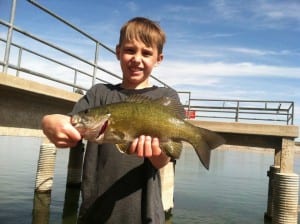NEWS RELEASE — St. Paul, MN – Dirk Peterson won’t tell anglers where to catch a big fish, but he can tell them what’s needed to make sure there are big fish to catch when they get there.
More and more these days, he’s boiling it down to three words: good fish habitat. More habitat articles at fishiding.com
Peterson is in charge of the Minnesota Department of Natural Resources’ (DNR) fisheries section, which has just launched a new fisheries habitat plan. It outlines a strategic road map for making sure the state’s 10,000 lakes and hundreds of rivers and streams continue to provide the healthy aquatic habitat underpinning great fishing.
Pete Jacobson, a DNR fisheries research supervisor and one of the plan’s authors, makes it sound pretty simple. “The reason we have good fishing in Minnesota is because we have many lakes and streams with good water quality and habitat,” he said. “Healthy fish habitat is critical.”
But assuring the future of healthy aquatic habitat is anything but simple, because clean water depends on all that happens across a watershed, the hundreds or thousands of acres that drain into any particular lake or stream.
“When you lift a fish out of the water, that fish is a reflection of all that happens on the land,” Peterson said. “If we want to maintain great fishing, we need to focus more effort at the landscape and watershed scale.”
Peterson compares fisheries management to a three-legged stool: one leg is stocking fish, one leg is regulations that help control harvest, and one leg is habitat. Historically, the first two legs have been a little longer and more robust than the last one. The new plan aims to rectify that imbalance by directing staff and other resources to habitat protection and restoration.
While past fisheries habitat projects focused more on near-shore efforts such as protecting aquatic vegetation and stream channel improvements, the new approach seeks to move away from the water’s edge to encompass entire watersheds.
Because the DNR has little authority over land use – a chief determinant of water quality – working at the watershed level will rely more extensively on collaboration and coordination with other DNR divisions, local government, landowners, and other state and federal agencies.
Now there’s collaboration with DNR’s Forestry Division and local soil and water conservation districts to protect the watersheds of lakes with healthy populations of tullibee, a coldwater species sensitive to water quality, which provides important forage for game fish.
In the metro region, watershed scale collaborations with local government and other agencies have helped protect several trout streams, including Dakota County’s Vermillion River, a trophy brown trout stream just a half hour from downtown St. Paul.
While DNR fisheries has undertaken a few larger scale habitat projects before, they tended to be few and far between because there was little funding for big-picture, long-term approaches. The passage in 2008 of a state constitutional amendment dedicating a portion of a sales tax hike to the outdoors and to clean water has changed that. Much of the new habitat plan, available on the DNR website athttp://www.files.dnr.state.mn.us/fish_wildlife/fisheries/habitat/2013_fishhabitatplan.pdf, is aimed at better coordination and focus of funding sources to achieve the most bang for the buck.
An increase in fishing license fees – approved by the Minnesota Legislature last year – also is helping to put more focus on fisheries habitat work.
“We’ve always talked about habitat, but there rarely was adequate funding to really attack it at the appropriate scale,” said Jacobson, the fisheries researcher. “The constitutional amendment changes that, and we need to take advantage of it. The amendment is a mandate from the people for us to take fish habitat conservation seriously. This plan helps us do that.”By Site Editor

